Phytophthora on potatoes: ways to combat and treat, how to spray - the best means
Late blight is one of the most harmful diseases affecting plants from the Solanaceae family (especially potatoes and tomatoes). That is why protecting potatoes from late blight is the most important task for any summer resident who is counting on a decent harvest.
In this article, we will talk about what late blight on potatoes is, how it manifests itself, what are the causes and conditions for the development of the fungus, as well as how to effectively deal with this disease, what treatments exist and how to prevent late blight of potatoes.
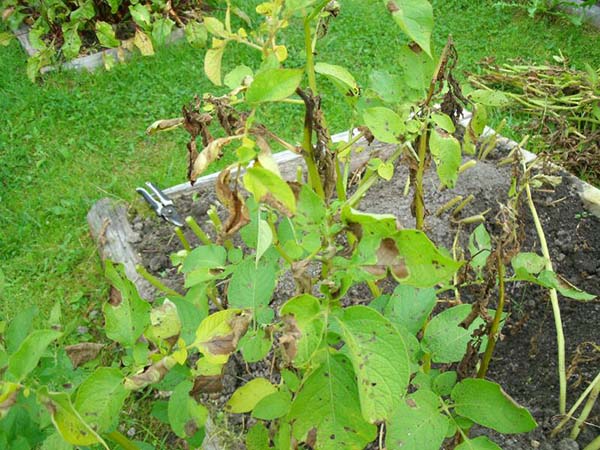
Content
What is potato late blight: signs of a fungal disease
Late blight, according to many gardeners, is the main (most harmful) fungal disease of potatoes and tomato.
The causative agent of the disease is the fungus Phytophthora infestans.
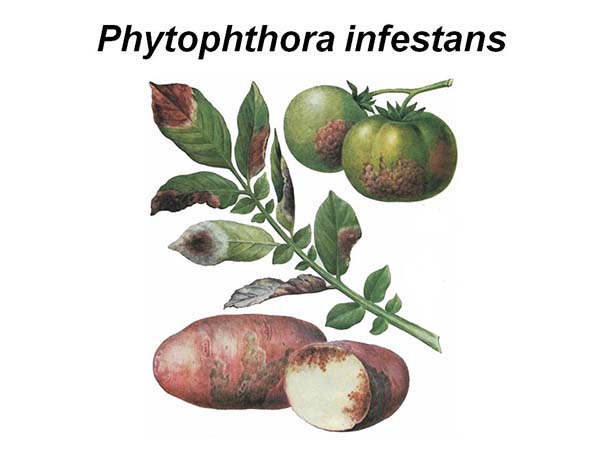
Phytophthora affects all parts of potatoes - first the leaves and stems, and then the tubers.
On the upper side of the leaves (especially in the lower part of the bush), as well as in some parts of the stem, small, but rapidly increasing dark brown spots... As a result, the leaves quickly enough begin to wilt (die off), turn black and dry out or rot (in wet weather). As a result, the potato tops look like they are burnt.
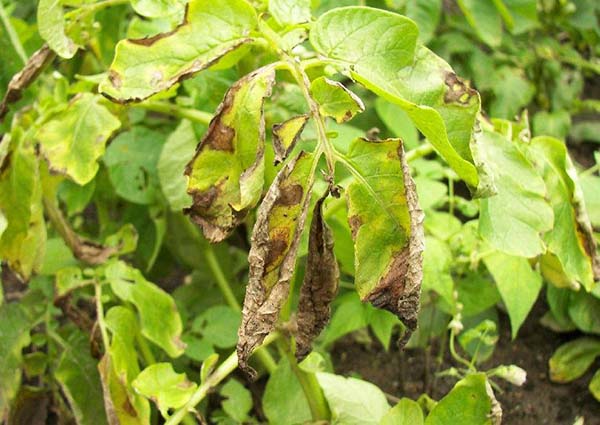
In damp weather or with morning dew, you can easily see the spores of the fungus (whitish cobweb bloom) on bottom (back) side leaf around the spots.
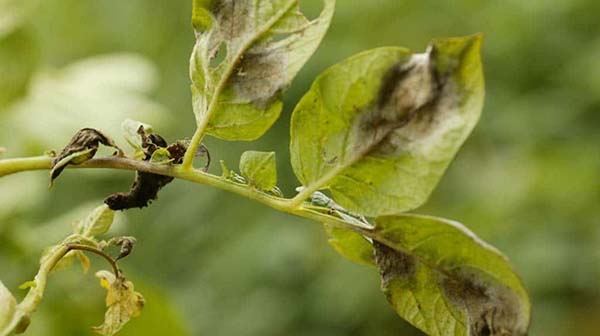
On tubers late blight manifests itself in the form brown rot. First, sharp grayish, and then brown, slightly depressed hard spots of various sizes appear on the surface of the tuber. Then, already upon cutting, a rusty coloration of the pulp will be visible under the stain, which spreads into the tuber in the form of tongues or wedges.
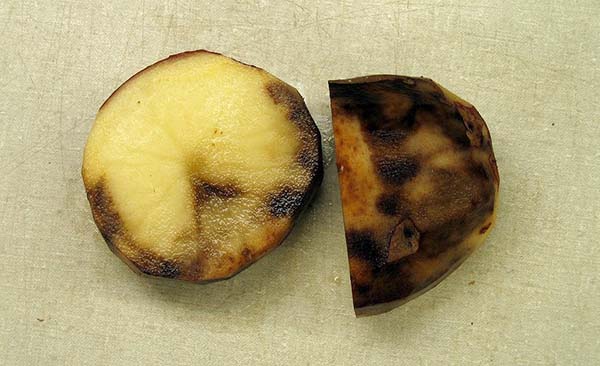
Interesting! Potato tubers become infected during heavy rains, when pathogens enter the soil from leaves, or during harvest, when they (tubers) come into contact with the surface layer of the soil or with the affected tops (therefore, it is necessary in advance mow and clear from the site).
Also, the penetration of the phytophthora fungus into the tubers is facilitated by mechanical damage when digging potatoes.
The most favorable conditions for the development of late blight on potatoes are humid and moderately warm weather.
Interesting! If earlier the causative agent of the disease developed at a relatively cool temperature from +8 to +23 degrees, now its development occurs in a wider temperature regime - from +3 to +32 degrees
Prolonged rains, abundant dew, prolonged fogs, which are especially characteristic of the end of summer, when strong fluctuations in day and night temperatures begin, - these are the most favorable conditions for the manifestation of late blight on potatoes.
By the way! The spores of the fungus can be carried over great distances by heavy rains in windy weather.
But the main danger of phytophthora is that under favorable conditions for its development, it multiplies very quickly, we can say that it exponentially. Therefore, if you do not start to take measures in time, then you will simply be left without a crop.
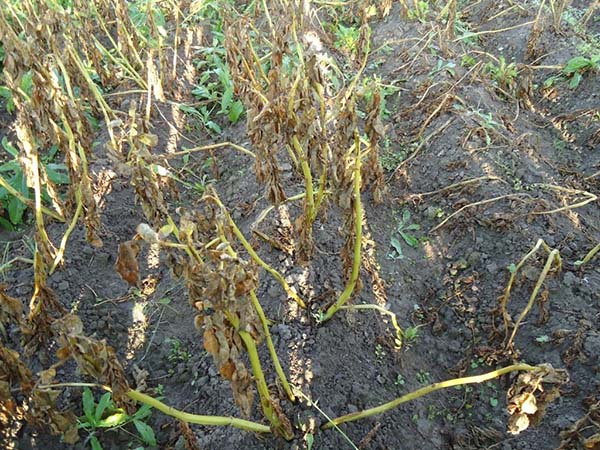
Measures and methods for the prevention of late blight of potatoes
It is obvious that the development of phytophthora on potatoes is often trite easier to prevent by taking several preventive measures than then trying to cure already affected plants.
Therefore, first of all, you need to try to prevent the appearance of late blight in your garden, in which the following tips and recommendations will help you:
- First, it should use only healthy seed, namely, be sure to carry out pre-planting treatment (pickling) of potato tubers from diseases and pests.
Important! Unfortunately, no treatment will save you from late blight, except that you can use special preparations (Ribav Extra, Fitozont) to increase resistance to late blight.
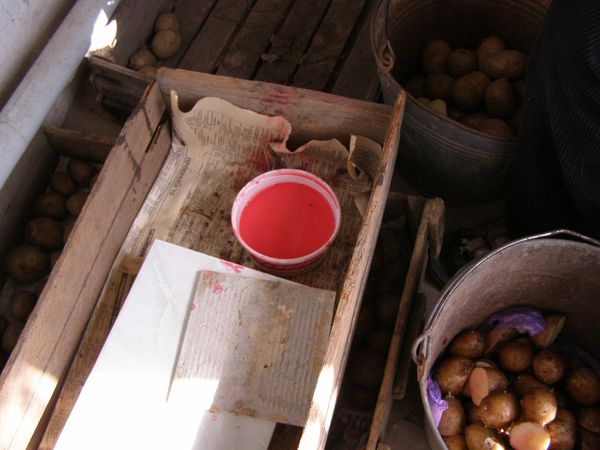
- Secondly, if the risk of late blight is extremely high, then it is recommended to plant most disease resistant varieties either grow early ripening varietiesin order to have time to harvest the crop before the onset of favorable weather conditions for the development of late blight (i.e. before the end of summer).
- Third, it is necessary observe crop rotation, namely you can not plant potatoes in placewhere last year were grown tomato.
Naturally, plant potatoes after potatoes - this is also very bad idea, especially if last year you already had an outbreak of late blight.
The thing is that the spores of the fungus winter well in the soil.
In general, the source of primary infection is tubers affected by late blight, in which the fungus remains for the winter in the form of mycelium.
- Fourth, not should allow close proximity potato and tomato beds.
- Fifth, to reduce the likelihood of the penetration of spores with rains to the tubers above them, form sufficiently high and wide ridges, i.e. it is necessary to carry out the correct fit.
Advice! The site has detailed material about how to plant potatoes correctly.
- Sixth, well prepared and fertilized (= fertile) soil (potash fertilizers and trace elements - boron, copper, manganese) is another important preventive component for increasing potato resistance to late blight.
- Seventh, not should dig up a crop in rainy weather, important collect it correctly and in a timely manner, prepare for storage, transport and keep.
Important! If you notice traces of phytophthora on your bushes, then before digging out potatoes, it is imperative get rid of all its tops, and by doing this 2-3 weeks before harvest.
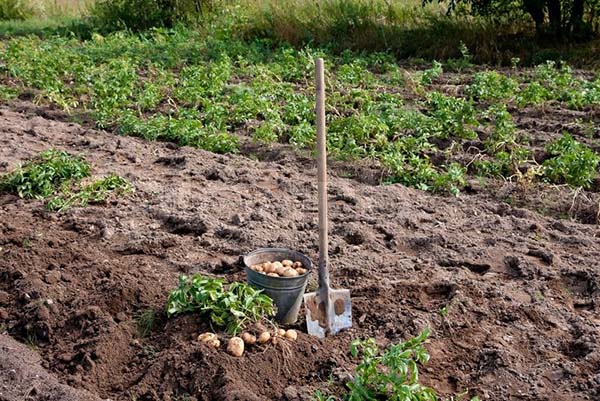
The fact is that phytophthora spores persist in the soil and, in the presence of moisture, infect tubers during harvesting, transportation and storage.
Note! All the information about when and how to properly harvest potatoes, you'll find in this article, but about that how to prepare tubers (dry, dress) and store properly — in this material.
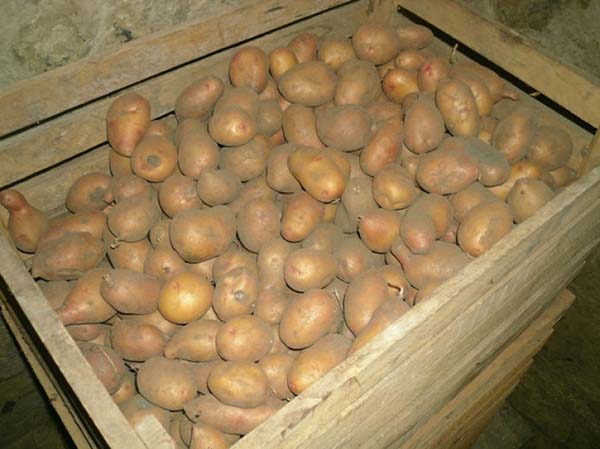
If you notice the first signs of late blight on potatoes, it is urgent to start spraying with chemical or biological fungicides (of course, the sooner the better).
Actually, you can (and should) start conducting preventive protective spraying, when there are no signs of disease on the plants yet; even more so if you know that late blight is likely to appear in your region.
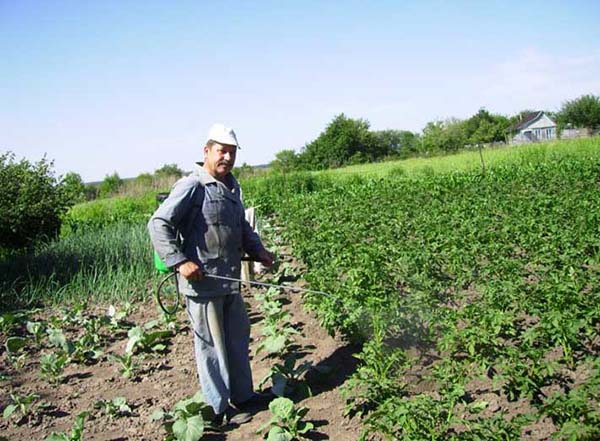
When and how to process potatoes from late blight
Now let's figure out what means should be used to protect potatoes from late blight, than to process if you find the first signs of the disease on your bushes.
Now on sale you can find a huge number of agents (fungicides - drugs against diseases) that can effectively fight late blight, which are of chemical and biological origin.
Note! Many gardeners have a preconceived opinion that the use of chemicals has a negative impact (has negative consequences) on the quality of the future harvest and human health. However, this does not correspond to reality, since after the expiration of the waiting period, all harmful substances (pesticides) are removed long before ripening and digging of the crop.
In contrast to biological products, chemical agents act much faster and more reliably. In addition, the use of chemicals is very often the only way to cure a culture of fungal diseases.
Alternatively, you can apply either copper-containing products or others contact (which are washed off by rain, in other words, in case of precipitation, re-treatment will be required), or systemic (penetrate into the plant and remain for a certain period) drugs protective and healing action.
Worth knowing! Many fungicides are only aimed at preventing disease, not treating it. Therefore, it is much more convenient to use drugs with a wide spectrum of action, which simultaneously protect plantings from late blight, and also have a healing effect.
Terms and scheme of processing
It makes sense that certain fungicides should be used depending on the phase of plant development.
Thus, an approximate scheme for treating potatoes from late blight can be as follows:
- From the moment of germination to the beginning of the closing of the tops - contact (less often systemic) means of protective action are used, i.e. for example Bravo, Ditan M-45, Shirlan, Infinito, Consento, Metaxil, copper-based preparations and others.
Note! This spraying is carried out exclusively in the case of a high probability of early manifestation of late blight, i.e. processing is of a purely preventive nature.
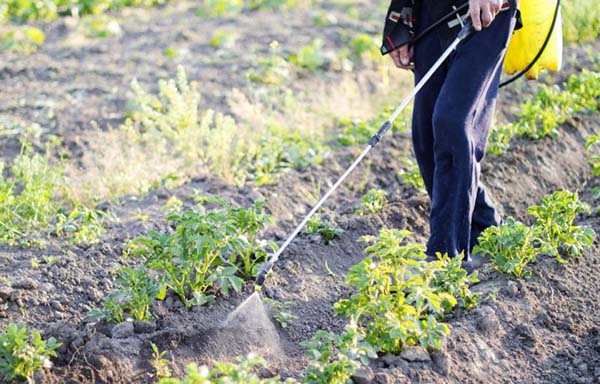
- From the beginning of the closing of the tops to flowering (i.e. in the period of closing the tops in rows and the beginning of budding, when the bushes are 30-40 cm high) - it is better to use systemic or contact-system (local-system) means of protective and curative action, i.e. for example Ridomil Gold, Revus Top or simply Revus, Infinito, Consento, Metaxil, Rapid Gold, Ordan MC, Profit Gold, Thanos, Ordan, Acrobat MC.
By the way! During this period, it is especially important to protect the new growth of leaves, because the amount of tops doubles every 4-5 days. Moreover, under the canopy of closed foliage, the most favorable conditions for infection of the leaves are created.
- After flowering and before the tops die off - already use contact (Shirlan, Ditan M-45, Hom) or local-systemic fungicides (Oksikhom, Akrobat MC, Ordan, Ordan MC, Kurzat R, Rapid Gold).
During this period, the growth of leaves stops, so the main goal is to protect potato tubers from late blight. Actually, it is at this phase that the risk of developing phytophthora is maximum.
As for the number of sprays, as a rule, on average, 3-7 treatments are carried out: 1 treatment - before closing, 1-2 treatments - during the closing of the tops and 1-4 treatments - after flowering, i.e. every 7-14 days (after 7-10 days for potato varieties susceptible to late blight and after 10-14 - for resistant ones).
By the way! The last processing is carried out 14-20 days before harvesting.
Thus, it is necessary to fight late blight systematically and continuously, the treatments must follow one after the other: the period of action of the fungicide ends - carry out the next spraying. Moreover, the tops had to be protected until they completely die off or are removed, since the tubers can become infected with late blight even with a slight damage to the tops.
Chemicals
Advice! Treatments should be carried out alternately, i.e. alternate fungicides from different groups, in other words, use drugs with different active ingredients, so as not to cause addiction and adaptation of the fungus.
The following chemical fungicides are called the most effective means for combating late blight on potatoes (the active ingredients, the method of penetration and the nature of the effect are given in brackets):
- The simplest copper-containing products are copper sulfate and bordeaux mix.
By the way! It is believed that inkstone against late blight acts even better than copper.
Recipe: iron vitriol - 50 g, carbamide (urea) - 30 g, slaked lime - 20 g per 10 liters of water.
The content of ferrous sulfate in such a solution is only 0.5%, and it is completely non-toxic to plants.
- Hom (Copper oxychloride, protective contact fungicide);
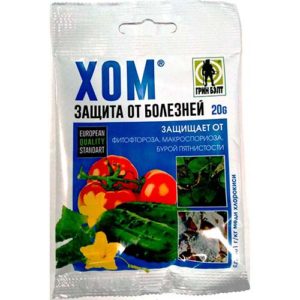
- Oxyhom (Copper oxychloride and Oxadixil, systemic contact protective fungicide);
- Bravo (Chlorothalonil, a protective contact fungicide);
- Shirlan (Fluazinam, a protective contact fungicide);
- Ditan M-45 (Mancozeb, a protective contact fungicide);
- Infinito (Propamocarb hydrochloride and Fluopicolide, systemic contact protective fungicide);
- Consento (Propamocarb hydrochloride and Fenamidone, a protective systemic fungicide);
- Metaxil (Mancozeb and Metalaxil, systemic contact protective fungicide);
- Revus Top (Difenoconazole and Mandipropamide, systemic contact fungicide of protective and healing action);
Also still exists simply Revus - a systemic drug of protective-healing action, but only on the basis of Mandipropamide.
- Rapid Gold (Mancozeb and Cymoxanil, fungicide of contact and local-systemic protective-healing action);
- Profit Gold (Famoxadon and Cymoxanil, systemic contact fungicide of protective and healing action);
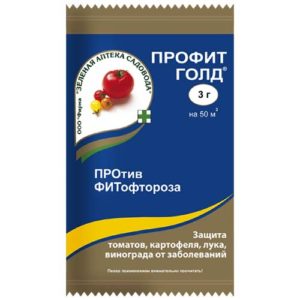
- Thanos (Famoxadon and Cymoxanil, systemic contact fungicide of protective and healing action);
Thanos = Profit Gold.
- Ridomil Gold (Mancozeb and Mefenoxam, systemic contact fungicide of protective and healing action);
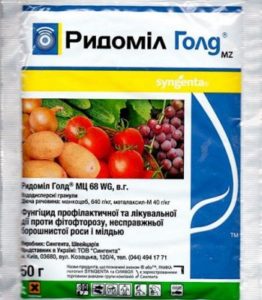
- Acrobat MC (Dimethomorph and Mancozeb, contact-systemic (local-systemic) fungicide of protective and healing action).
- Kurzat R (Copper oxychloride and Cymoxanil), contact-systemic (local-systemic) fungicide of protective and healing action).
Kurzat R = Ordan.
- Ordan (Copper oxychloride and Cymoxanil, contact-systemic (local-systemic) protective and healing action).
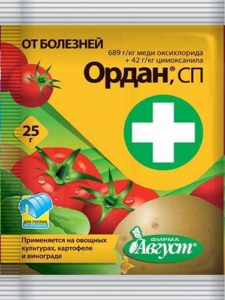
There is also Ordan MC, in which the active ingredients are Mancozeb and Cymoxanil, i.e. actually it Rapid Gold.
Biological agents
Biological preparations that are quite effective against late blight on potatoes include the following:
- Alirin-B (Bacillus subtilis strain B-10 VIZR, systemic contact pesticide of protective, curative and immunizing action);
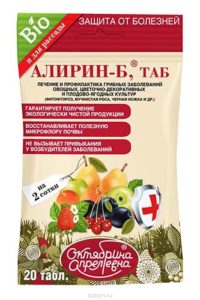
- Gamair (Bacillus subtilis strain M-22 VIZR, systemic contact pesticide of protective, curative and immunizing action);
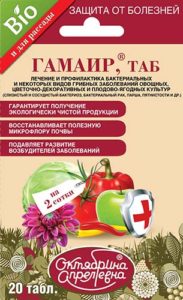
Interesting! The meaning of the immunizing action is that these agents reduce pesticidal stress in plants when used in tank mixtures with chemical pesticides.
- Trichoderma Veride (Trichoderma veride, strain 471, protective action);
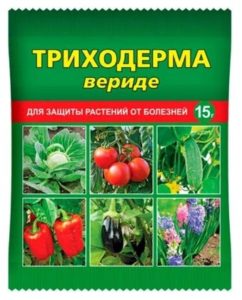
Trichoderma is just perfect for preventive treatments.
- Fitosporin (Bacillus subtilis strain 26 D, systemic pesticide of protective and curative action).
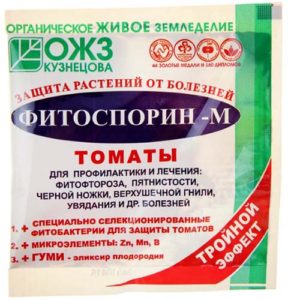
It is worth understanding! Biological agents are mostly recommended for prophylactic purposes or at very early stages of the development of the disease, when the lesion is still insignificant.
Folk remedies against late blight of potatoes
Naturally, there are also folk remedies for fighting late blight on potatoes, which were used by our ancestors, and which are called "grandfathers".
However, their effectiveness is rather dubious (in the overwhelming majority of cases they are practically ineffective), but if you try and the result satisfies you, then you are in luck (but most likely, you just had good growing conditions), if not then we warned you.
And in the next video of the Procvetok channel, the presenter talks about the myths of using various pharmaceutical and folk remedies, which will be listed below.
Infusion of garlic
Perhaps this is the most universal and folk remedy for all diseases and even insect pests. You will need to take 100-200 grams of chopped heads of garlic and pour 1 liter of warm water, then let it brew for 4-5 hours (some sources recommend up to a day). At the end, add another 9 liters of water, thus bringing it to 10, strain, pour into the sprayer and process.
By the way! For better adhesion, milk (250-500 ml) can be added to the solution.
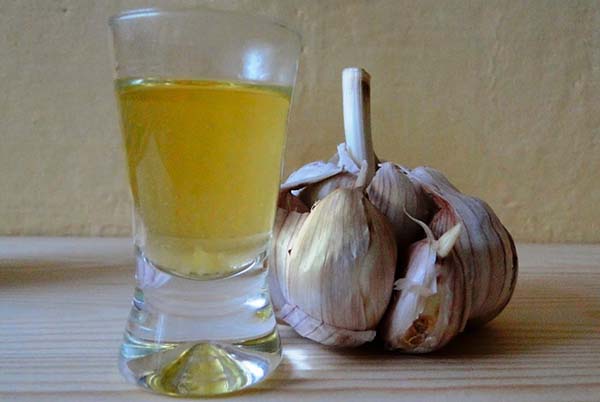
Milk serum
Sour milk whey should be diluted in half (i.e. 1 to 1) with water and preventive spraying should be started from the middle of summer.
Infusion of rotted hay
Actually, the meaning of this folk remedy is actually getting a hay stick, i.e. similar to application Fitosporin... You need to pour about 1 kg of hay in a bucket of water (10 liters), let it brew for 3-4 days, strain and start regular preventive treatments.
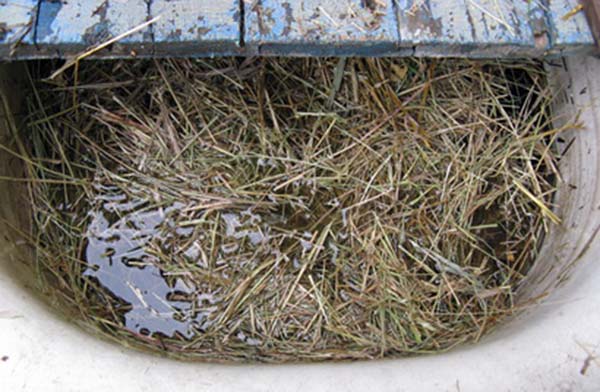
Soap-ash solution
100-200 grams wood ash pour 10 liters of hot water, bring to a boil. After the solution has cooled, strain and add 30-40 g of liquid soap.
Iodine and milk
To prepare the solution, you need to take 0.5-1 liter of milk for 10 liters of water, and also add 10-15 drops of iodine.
Important! According to the results of the experiment of the Procvetok channel, iodine is absolutely ineffective against late blight.
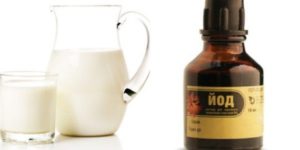
Interesting! Some summer residents advise adding Trichopol to this iodine-milk solution to increase efficiency (which, again, is pointless).
Trichopolus
Of course, where without pharmaceutical drugs! So, for processing, it is recommended to dissolve 10 tablets of Trichopol (Metronidazole) in 10 liters of water.
Important! According to the results of the experiment of the Procvetok channel, the remedy is absolutely ineffective (even, on the contrary, phytotoxic), and the "Tricho" prefix does not in any way belong to the really effective "Trichoderma" remedy.
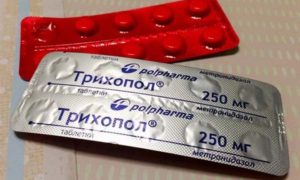
Zelenka (brilliant green)
Another absolutely useless remedy in the fight both specifically against late blight, and in general with all other fungal diseases.
Flaxseed oil or fish oil
And here is already a completely effective and proven remedy against late blight on potatoes aboutt channel Procvetok:
“For application on the leaves, take 1-2 teaspoons of linseed oil or fish oil (5-10 ml; up to three tablespoons, up to 50 g, if the risks of infection are very high, and precipitation will pass earlier than 12 hours after applying the solution on the leaves) and thoroughly mixed with a soap solution (40-50 g of laundry soap per 10 liters of water). Then it all dissolves in a bucket of water. Treat the leaves evenly, you can repeat it after 2-3 weeks. It's nice to add to the solution boric acid (due to the small amount, it will not affect the soap), microelement dressings, potassium humate and other substances compatible with alkaline solutions (for example, Epin and pyrethroid-based insecticides are not compatible). "
Video: how to treat late blight of potatoes and tomatoes
Thus, now you know what potato late blight is and understand the importance of preventive measures and treatments against this most dangerous disease. The choice of spraying agents for late blight on potatoes is huge, so you just have to buy a few, perform treatments and see the results.
Video: protecting potatoes from late blight

